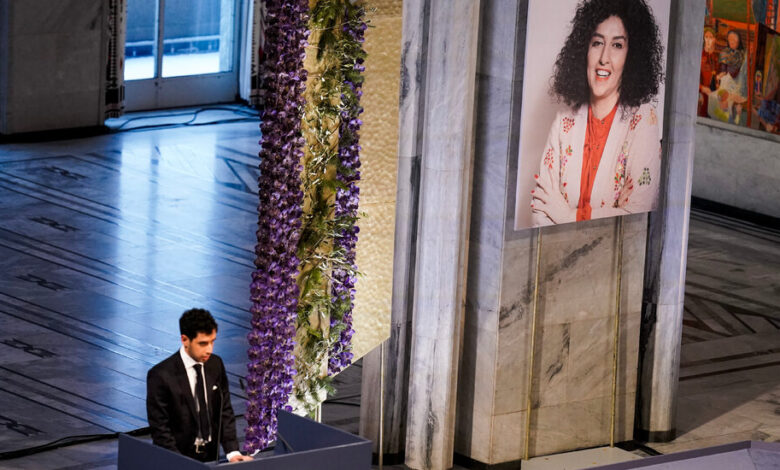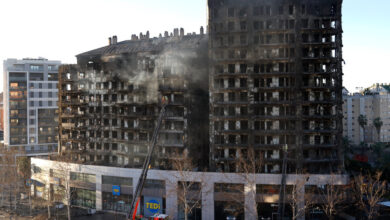
[ad_1]
The Iranian regime sentenced Narges Mohammadi, the jailed human rights activist who received the 2023 Nobel Peace Prize, to 15 more months in prison, her family said on Monday.
The news came a day after Iran released the journalists Niloufar Hamedi and Elaheh Mohammadi on bail while they appeal their sentences, according to state media. They had been jailed for their coverage of a young woman whose death sparked a nationwide protest movement that challenged the country’s system of authoritarian clerical rule. Prosecutors filed a new complaint against the women on Monday.
The journalists helped break the story of Mahsa Amini, 22, who died in the custody of Iran’s morality police in September 2022 after being arrested on charges of violating Iran’s religiously conservative dress code.
Ms. Hamedi, 31, reported for the Iranian daily newspaper Shargh from the hospital where the young woman lay dying and shared a photo of her grieving relatives that went viral on social media. She was arrested days after Ms. Amini’s death, and Ms. Mohammadi, who had covered her funeral for the newspaper Hammihan, was arrested a week after that, as protests swept Iran.
Both women were charged with conspiring with foreign intelligence agencies to undermine national security, as well as spreading propaganda, and spent months in detention. After closed-door trials, they were sentenced in October — Ms. Hamedi to 13 years in prison and Ms. Mohammadi to 12 years.
Narges Mohammadi, 51, has spent most of the last decade in and out of prison, charged with “spreading anti-state propaganda” — part of Iran’s long campaign to silence and punish her for her activism.
Her family said a new trial was held Dec. 19 without her present, and the sentence was her fifth conviction since 2021. In total, her family said, she has been sentenced to more than 12 years in prison, 154 lashes, four months’ travel ban and two years’ exile.
“The judgment resembles a political statement against Narges Mohammadi, emphasizing accusations that she repeatedly incites and encourages public and individual opinions against the Islamic regime to sow chaos and disturbances,” her family wrote on the platform Threads.
But her imprisonment has not stopped her, even though she has suffered severe health problems, including a heart attack. She has remained one of the most outspoken critics of Iran’s government.
In response to a major uprising, led by women, that rocked Iran after Ms. Amini died, Narges Mohammadi organized prison protests, wrote opinion pieces and led weekly workshops for female inmates about their rights.
Video posted on the Instagram account of the journalist Elaheh Mohammadi’s sister showed the two released journalists leaving Tehran’s notorious Evin Prison and walking hand in hand toward their husbands, colleagues and friends who were running uphill to greet them. As they all hugged, the crowd chanted, “Freedom, freedom, freedom.”
Friends also posted photos on social media of the journalists walking down the street with hands raised in the victory sign — with the hair of both women falling loosely, in violation of Iran’s religiously conservative dress code.
The official response was swift: On Monday, Mizan, a news agency overseen by Iran’s judiciary, reported that prosecutors had filed a new complaint against the journalists, accusing them of breaking the hijab law. That legislation requires women to cover their hair and wear long, loose clothing that hides the shape of their bodies. That is what initially led to the arrest of Ms. Amini.
The morality police who detained Ms. Amini took her to a center for re-educating women on the law governing dress before she was hospitalized. The Iranian government has said that she died while in custody because of underlying medical issues. Her family has said that she had no health issues, and that she died because the police beat her.
A photo of Ms. Amini in a coma in the hospital with blood dripping from her ear and tubes in her mouth went viral. No independent investigation was conducted.
Ms. Amini’s death outraged Iranians already furious with their government over decades of social and political repression, as well as economic mismanagement and corruption, igniting monthslong protests. Tens of thousands of people took to the streets across Iran, including many women who ripped off their headscarves and burned them in bonfires. The uprising — called the “Mahsa movement” in homage to Ms. Amini — morphed into the most serious challenge to the legitimacy of Iran’s ruling clerics since they took power in 1979.
Iran’s government cracked down, and by early 2023 had quelled the protests by force, arresting nearly 20,000 people and killing more than 500, according to human rights groups. At least seven arrested protesters were later executed, and others are still facing the death penalty.
Still, many women have continued to defy the hijab law, especially in larger cities, by keeping their hair uncovered and wearing Western-style clothing in public. In response, the government has tried a variety of measures to enforce the law, including shutting down businesses that turn a blind eye to customers’ dress code violations and banning banks and government offices from serving such women.
In September, the Iranian Parliament approved a bill that increased the penalties for women who refused to wear the hijab, imposing large fines and prison time for violators.
On Monday, the photos of the two journalists with their hair uncovered drew approving comments on social media from Iranians who saw them as symbols of defiance toward the government. Ms. Amini’s loved ones joined in celebrating their freedom.
“The news of your release after four hundred days of enduring prison and being away from your family made us all happy and sweetened our palates,” Ms. Amini’s father, Amjad Amini, wrote on Instagram on Sunday. “I sincerely congratulate you and your brave and patient family on this precious freedom.”
[ad_2]
Source link




